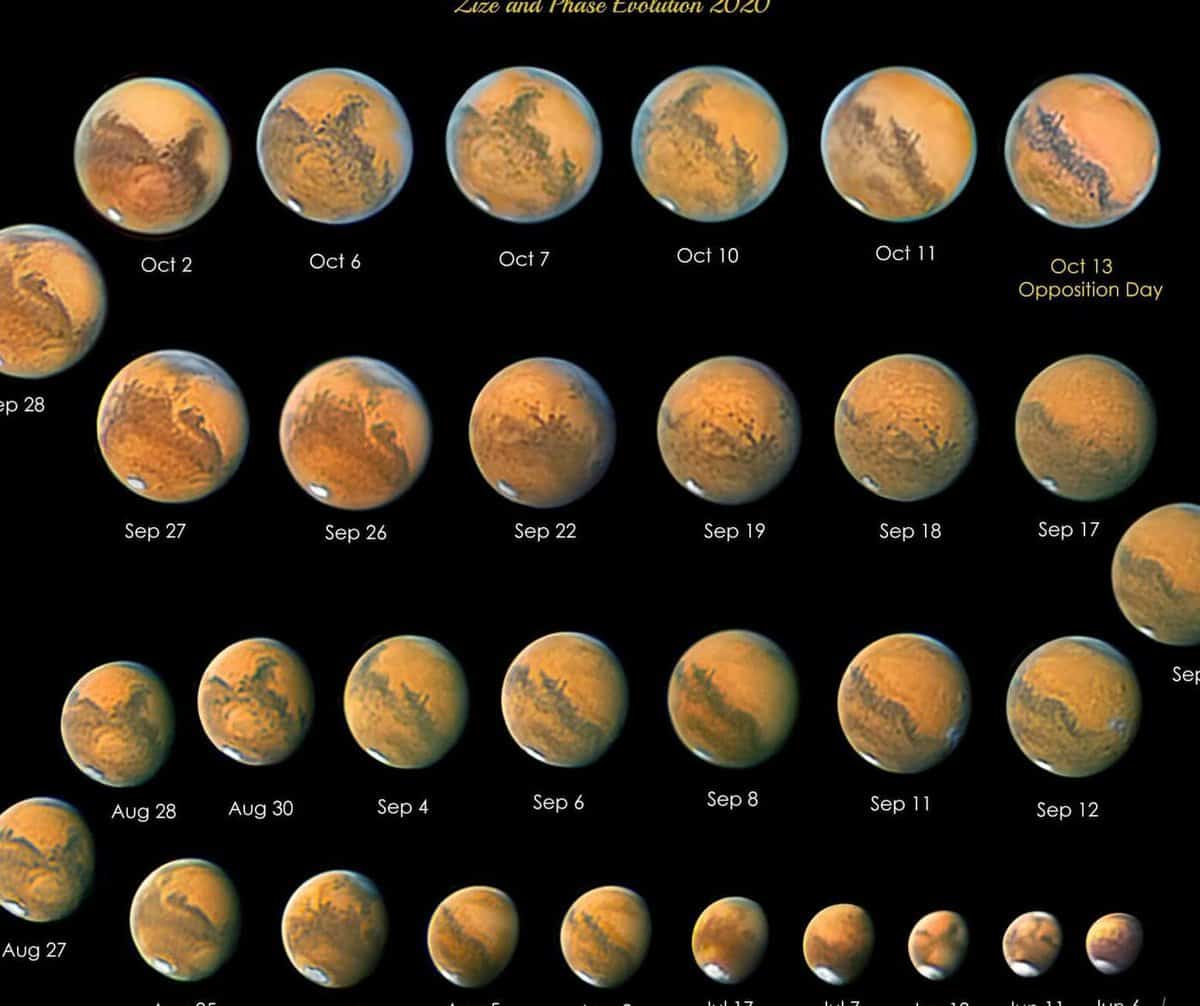
Mercury and Venus in the celestial sphere – tips for observing the first two planets from the Sun: selecting the appropriate telescope and filters, optimal observing times and directions, captivating planetary imagery, and even capturing Venus during the daytime.
Mercury and Venus present themselves as the most accessible planets to observe due to their close proximity to Earth and their historical significance as the Morning and Evening Star. However, it is crucial to familiarize oneself with the methods for locating and differentiating Mercury and Venus from other celestial bodies. Additionally, acquiring the proper telescope is essential for fully appreciating the splendid views and potentially capturing high-quality images of Mercury and Venus.
Mercury, the planet closest to the Sun, is located about 58 billion kilometers away from it. This planet has an extremely elongated orbit and completes a full revolution around the Sun in 88 days. Mercury’s atmosphere is highly rarefied and contains a significant amount of helium, with its pressure being 500 billion times lower than the pressure on Earth’s surface.
Venus, one of the most captivating celestial bodies in the night sky, shines brightly and is only surpassed in luminosity by the Sun and the Moon. It takes Venus 255 days to complete a full orbit around the Sun and 243 days to complete a rotation around its axis. This makes Venus the planet with the longest days in the entire solar system. The planet’s atmosphere is composed of approximately 96.5% carbon dioxide and 3.5% nitrogen.
Instrumentation
There are no specific distinctions in locating Mercury and Venus in the sky. However, there are a few tips to keep in mind. For instance, using an achromatic refractor for observing Venus is not effective as it introduces significant chromatic aberration to the image. This is particularly noticeable due to the planet’s intense brightness. It is preferable to have a Go-To or equatorial mount since studying the inner planets typically occurs during the daytime. Consequently, the use of regular alt-azimuth mounts is practically impossible in this scenario.
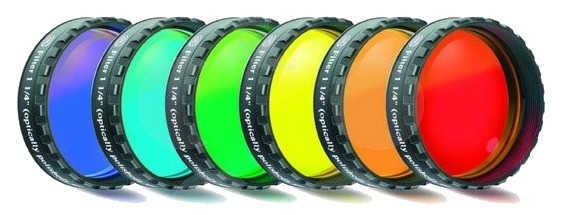
A collection of colored filters is an essential tool when it comes to observing Mercury and Venus.
When conducting visual studies, it can be incredibly challenging to see any surface details on Venus and Mercury. However, this should not cast doubt on the quality of optical telescopes. To address this issue, modern planetary eyepieces such as monocentrics and orthocentrics can be of great help.
It is crucial not to overlook the importance of having a set of color filters. This set should include dark red, red, and orange filters, which are specifically designed to enhance the contrast of the planets during observations in the twilight or daytime sky. Additionally, violet and blue filters can be utilized to visualize darker details on the planetary disks.
The Celestron Advanced VX 8″ N Telescope
The Celestron Omni XLT 150 Telescope
The Celestron NEXSTAR 102SLT Telescope
The Bresser Pollux 150/1400 EQ2 Telescope is an excellent choice for stargazers
The Bresser Messier AR-152S/760 EXOS-2/EQ5 Telescope
offers a unique and innovative design that sets it apart from other telescopes on the market. With its powerful magnification and high-quality optics, this telescope is perfect for both amateur and professional astronomers. Whether you’re observing distant galaxies or studying celestial objects in detail, the Bresser Messier AR-152S/760 EXOS-2/EQ5 Telescope will provide you with clear and crisp images. Its sturdy EXOS-2/EQ5 mount ensures stability and precision, allowing for smooth and accurate tracking of celestial objects. Discover the wonders of the universe with the Bresser Messier AR-152S/760 EXOS-2/EQ5 Telescope.
Bresser Messier NT-150S/750 EXOS-1 Telescope
The Synta Sky-Watcher Dob 8″ (200/1200) telescope is a unique piece of equipment
Synta Sky-Watcher Dob 8″ (200/1200) Retractable Telescope
When is the best time to observe Mercury?
Mercury is often referred to as the elusive planet due to its short visibility period compared to other planets. This is because Mercury orbits close to the Sun, making it difficult for residents in northern regions such as Russia, Great Britain, USA, and Scandinavian countries to observe it at night. However, astronomers in southern countries have the opportunity to observe Mercury once astronomical night falls.
The optimal moment to observe Mercury is when it reaches its maximum elongation, meaning it moves away from the Sun and appears at its highest point in the sky during the morning or evening twilight. In the northern latitudes, these periods occur in the spring, when Mercury is visible in the evenings, or in the autumn, when the planet can be observed early in the morning.
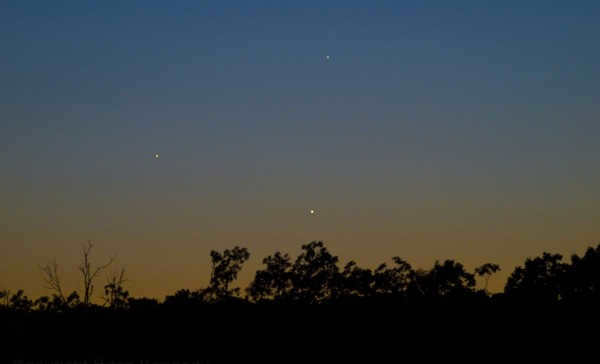
Mercury, Venus, and Jupiter are visible in the evening sky.
Observing Mercury
For beginner astronomers, observing Mercury may not be as exciting as observing Saturn, Jupiter, or the Moon. The planet’s appearance is not as visually appealing. However, those who are up for a challenge and appreciate the true beauty of Mercury will find it worth observing.
Despite this, not every seasoned amateur astronomer has had the opportunity to observe Mercury. Most enthusiasts are drawn to the allure of dim and dull galaxies, making it a pursuit only for the most dedicated researchers.
Where can we spot Mercury?
Wondering where to observe Mercury in the night sky? Well, spotting Mercury is quite easy and can be done with the naked eye. The best time to do this is usually a week before and after its maximum elongation. It’s ideal to have calm atmospheric conditions and no urban pollution or tall buildings around. During the spring season, Mercury can be seen in the evenings for approximately thirty minutes after sunset. The planet will be situated above the western part of the horizon. In the twilight sky, it is also possible to catch a glimpse of Mercury, but the clarity of the atmosphere and surrounding landscape play a significant role. During the autumn months, Mercury can be observed half an hour after sunrise in the morning sky. It remains visible to the naked eye for about sixty minutes before disappearing in the sunlight.
On days when Mercury is at its best, it shines with a brilliance of -1.3 magnitude, which is slightly dimmer than Sirius, the brightest star in the night sky. It’s important to note that Mercury’s position near the horizon and the presence of a thick, turbulent layer of air in its light path can cause it to twinkle and take on a pink or pale pink hue.
Using binoculars can greatly simplify the task of observing Mercury. It’s particularly easy to locate the planet just after sunset when the sky is still bright. Although binoculars won’t allow you to observe Mercury’s phases, they are an excellent tool for locating the planet and studying its interactions with other stars, planets, and the Moon.
Observing Mercury using a telescope
It is possible to observe Mercury through a telescope for approximately five weeks before and after its maximum visibility period. Nevertheless, it should be mentioned that studying this planet presents a highly challenging task. As previously mentioned, the relatively low position of Mercury in the sky prevents a comprehensive exploration of its features even with the aid of a telescope. The planet’s image is constantly distorted, stabilizing only during rare moments when astronomers can observe the most intriguing details.

One of the primary characteristics of Mercury is its phases, which can be observed using an 80mm telescope. To do this, it is necessary to increase the magnification of the instrument to 100x or higher. During maximum elongation, approximately 50% of Mercury’s disk is illuminated by the Sun. Phases with illumination below 30% or above 70% are not visible as the planet is positioned too close to the Sun during these periods.
A more challenging undertaking is to investigate the intricacies of the disk on Mercury. There exists a wealth of contradictory information regarding the characteristics of the close spots found on its surface. Certain astronomers claim that they can thoroughly examine the planet’s disk using an ordinary telescope, while others are unable to perceive anything on Mercury’s surface. Naturally, the effectiveness of the telescope is not the sole determining factor, as the observation conditions and the astronomer’s expertise also come into play.
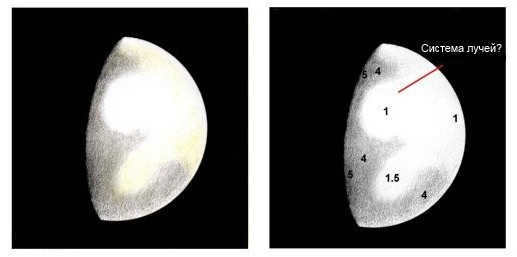
Observing the Surface of Mercury
When atmospheric conditions are optimal, using a telescope with a diameter of 100-120 mm during the moments of maximum elongation of the planet, it is possible to observe small dark patches near the equator line. However, inexperienced astronomers may struggle to discern these fine details on Mercury’s surface. With a telescope larger than 250 mm, it becomes possible to study larger dark patches located farther away from the equator. Rest assured, practicing your observation skills in this endeavor can be challenging yet incredibly enjoyable.
Observing Venus can be easier compared to Mercury, particularly if you have knowledge of where to locate it in the night sky. While this planet, similar to Mercury, is situated relatively close to the Sun, its apparent angular distance can reach up to 47˚. When it is at its maximum visibility, Venus reveals its disk for a few hours after sunset, appearing to the average person as the Evening Star, or before dawn as the Morning Star. Astronomers in the Northern Hemisphere have a better chance of observing Venus during its eastern elongation. On spring evenings, Venus becomes visible before midnight.
During its western or eastern elongation, Venus resides high above the horizon line and its brightness allows for effortless observations. Typically, the period of optimal visibility lasts for a month.
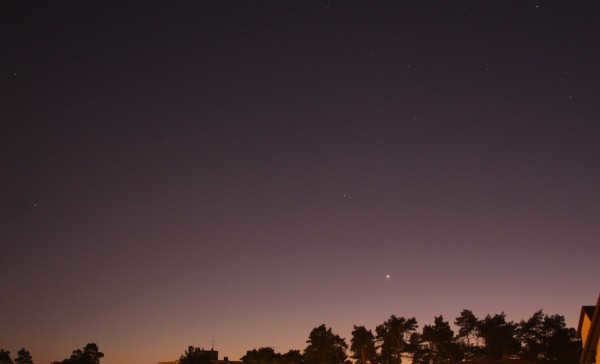
How to spot Venus in daylight without a telescope
One simple way to observe Venus without a telescope is to locate it during its morning rise. When conditions are optimal and the atmosphere is clear, Venus can be visible for a significant period of time. To make this task easier, you can use a natural or man-made obstruction, such as a tall tree, building, or other object, to block the sun while still allowing Venus to be visible. Of course, finding Venus during the day requires knowledge of its exact location. This information can be obtained from any planetarium program.
Of course, the task of spotting a small, barely noticeable spot of light in the sky during the day can be quite challenging. However, there is a simple trick. Start by gazing at the far-off horizon for a few moments, and then shift your eyes towards the specific area of the sky you want to observe. By doing this, you will keep your eyes fixed on infinity, making it easier to locate the planet you are looking for.
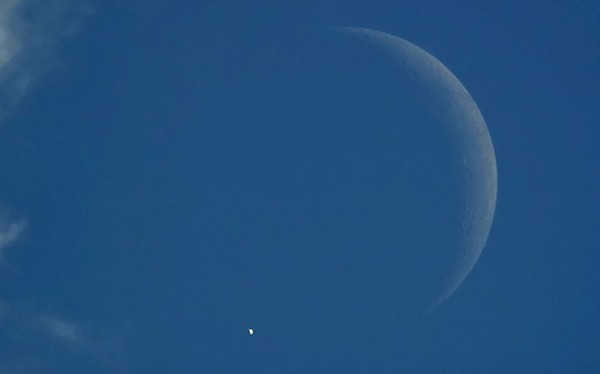
Venus and the Moon during daylight
Observing Venus using binoculars
Binoculars are an excellent tool for both searching and observing Venus. The wide field of view allows you to observe Venus as it approaches other planets and the Moon. Powerful astronomical binoculars, such as the 15×70 and 20×100, can even show the different phases of the planet when more than 40″ of its disk is visible.
Studying Venus with a telescope
Observing Venus during the day
The intense brightness of Venus can diminish the contrast of images, even when using basic telescopes. This can make it challenging to observe the planet’s phases and impossible to discern details on its surface. Nevertheless, there are several techniques to mitigate the brightness of Venus. Firstly, it is advisable to observe Venus during the daytime, and fortunately, this can be done year-round. The only exception is during the two weeks before and after Venus reaches its highest point of conjunction with the Sun.
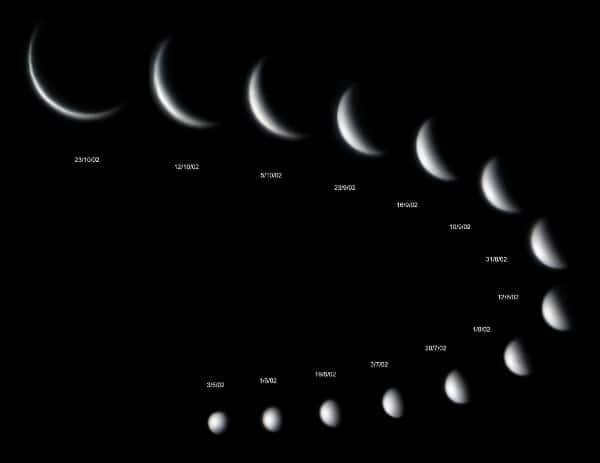

Phases of Venus. The picture was taken while observing in 2002
Using modern telescopes equipped with the Go-To auto pointing system makes it simple to locate Venus using the Sun alignment method. Another option is to find the planet using an equatorial-mounted telescope with alignment circles. Take care to align the mount accurately and then direct the telescope towards the Sun, keeping all safety precautions in mind. Next, align the coordinate arcs on the equatorial coordinates of the Sun, and only then can you gradually move the tube, aligning the coordinates of Venus with the coordinates on the setting circles. You can also use a search eyepiece for assistance. Keep in mind that adjusting the telescope’s focus on distant objects beforehand can make the search for Venus easier.
After successfully locating Venus, you can enhance your view with higher magnification. Consider getting a red or orange filter specifically designed to enhance the contrast between Venus and the sky background, bringing out the intricate details of its cloud cover. During the lower conjunction, Venus appears as a slender crescent shape. As you continue observing, you’ll be able to spot the horns of Venus, which curve around the planet’s disk with a faint, light-colored outline. This fascinating phenomenon is caused by the scattering of sunlight in Venus’ atmosphere.
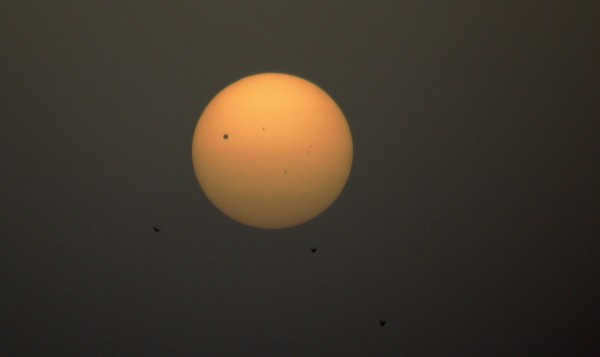
Observing the Transit of Venus through the Sun
Observing Venus at Night
While daytime observations of Venus offer numerous advantages, some astronomers prefer to study it during the night or twilight sky. During these times, finding the planet is not difficult. However, there are also some drawbacks. The main challenge is the overwhelming brightness, which makes it difficult to see the subtle details on Venus’ cloud cover. This issue can be addressed by using a special polarizing filter with adjustable density.
One drawback is the relatively low elevation of Venus above the horizon. Even during its peak visibility at night, Venus only reaches a maximum altitude of 30˚ above the horizon. It is common knowledge among astronomers that optimal astronomical observations should be made when an object is at an altitude greater than 30˚. Therefore, this limitation minimizes the negative impact of the atmosphere on image quality.

Venus and the Moon in the night sky
Exploring the mysterious patterns in the clouds of Venus
Most of the time, astronomers observe Venus as a featureless gray-white disk without any discernible details. However, under optimal atmospheric conditions, it is possible to discern a dark region along the terminator. Occasionally, skilled astronomers are able to identify peculiar dark formations with bizarre shapes. What factors contribute to the visibility of these details? This question remains unanswered to this day. Several factors come into play, including the quality of the equipment used, the conditions of observation, and the capabilities of the human eye.
Approximately three decades ago, the scientific community formulated the notion that certain individuals possess heightened sensitivity in their eyes to the ultraviolet spectrum. As a result, they are capable of perceiving obscure streaks and other formations on the planet Venus. This hypothesis was subsequently validated by images captured in the ultraviolet spectrum, which exhibited the presence of intricate details that remain imperceptible in conventional photographs. Furthermore, it is crucial to acknowledge the susceptibility of ardent astronomers to self-deception. In truth, these dark intricacies prove to be quite elusive, rendering it significantly more effortless to convince oneself of their existence rather than observe them in actuality.
Photographs of Venus procured by employing various filters
Currently, multiple categories of obscure features have been created:
- Radial: Obscure bands radiating outward from a central point.
- Ribboned: Obscure stripes that run parallel to each other and perpendicular to the edges of the formations.
- Irregular: Features with an undefined shape.
- Amorphous: Chaotic darkening without a specific form.
Luminous spots on Venus
If you are familiar with observing Venus in the sky, you may notice bright spots near the planet’s poles. These “polar spots” can be visible for days or even weeks. They gradually appear and disappear, with a higher frequency near the south pole and less frequently near the north pole.
Unusual Phenomena
Schroeter’s Effect
The Schroeter effect refers to the phenomenon of the moment of dichotomy being either advanced or delayed by several days (according to preliminary calculations). It is primarily observed in the lower planets and is caused by the scattering of sunlight along the terminator line.
Ashen Light
An optical illusion in which Venus appears as a narrow crescent. In some instances, a faint glow can be observed in the hidden portion of Venus.
Contour Irregularity
A combination of bright and dark features along the terminator line, creating the illusion of an uneven landscape. This phenomenon is challenging to perceive with the naked eye, but it becomes evident in astrophotographs. In these images, Venus resembles a piece of cheese with nibbled edges, as if mice have taken small bites from it.
Images of Mercury captured by hobbyist astronomers:
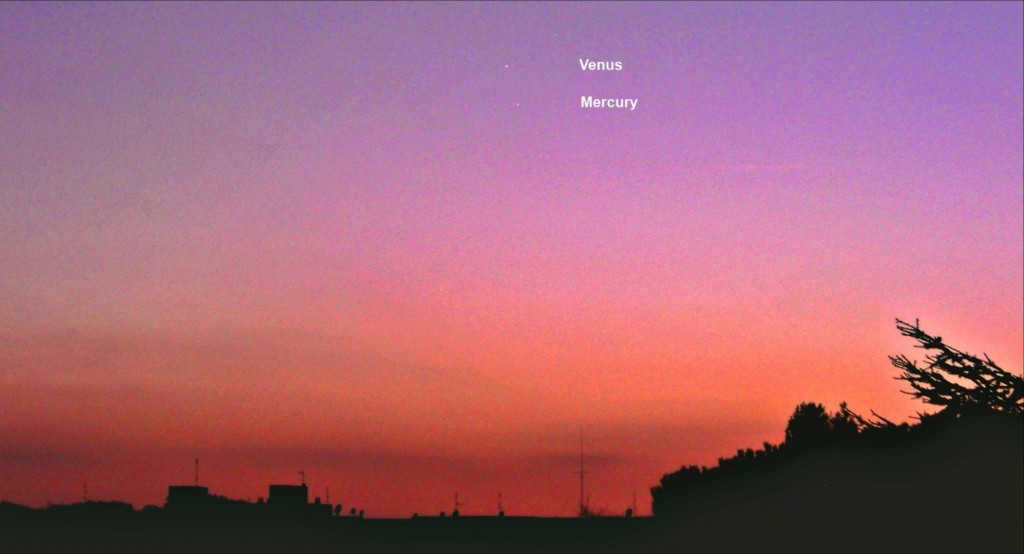
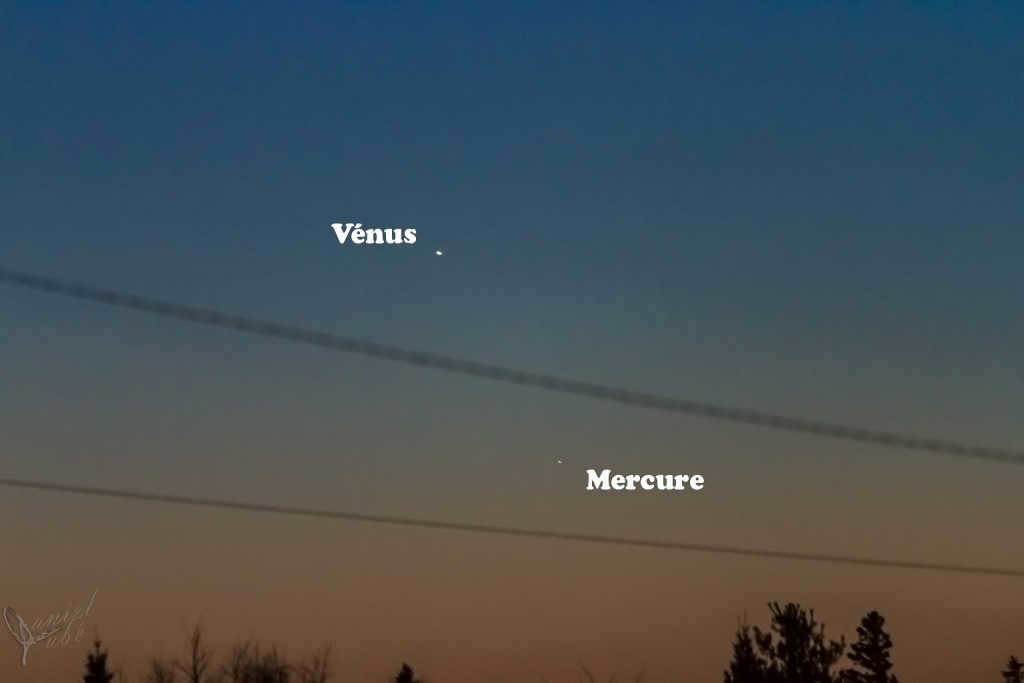
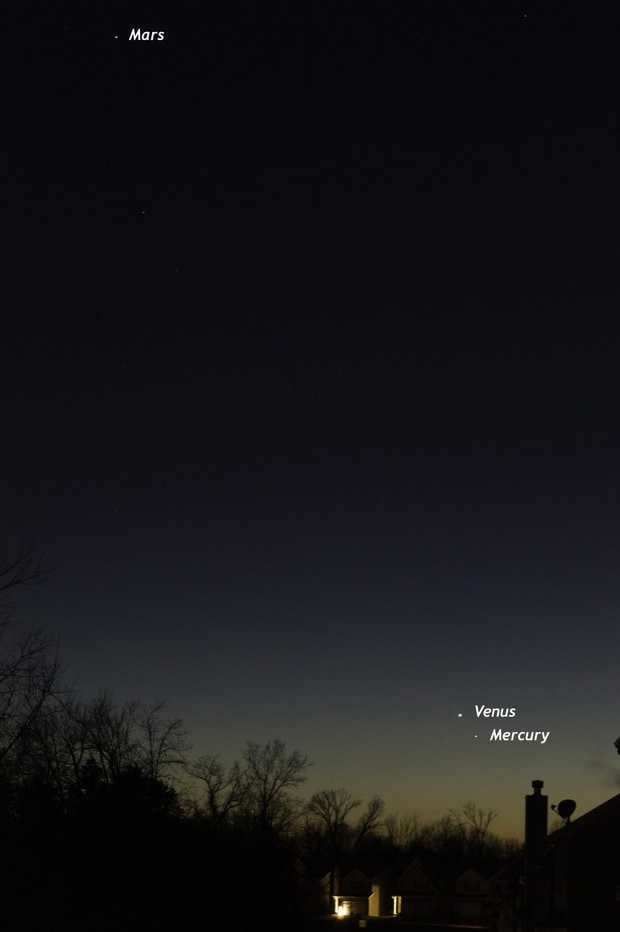
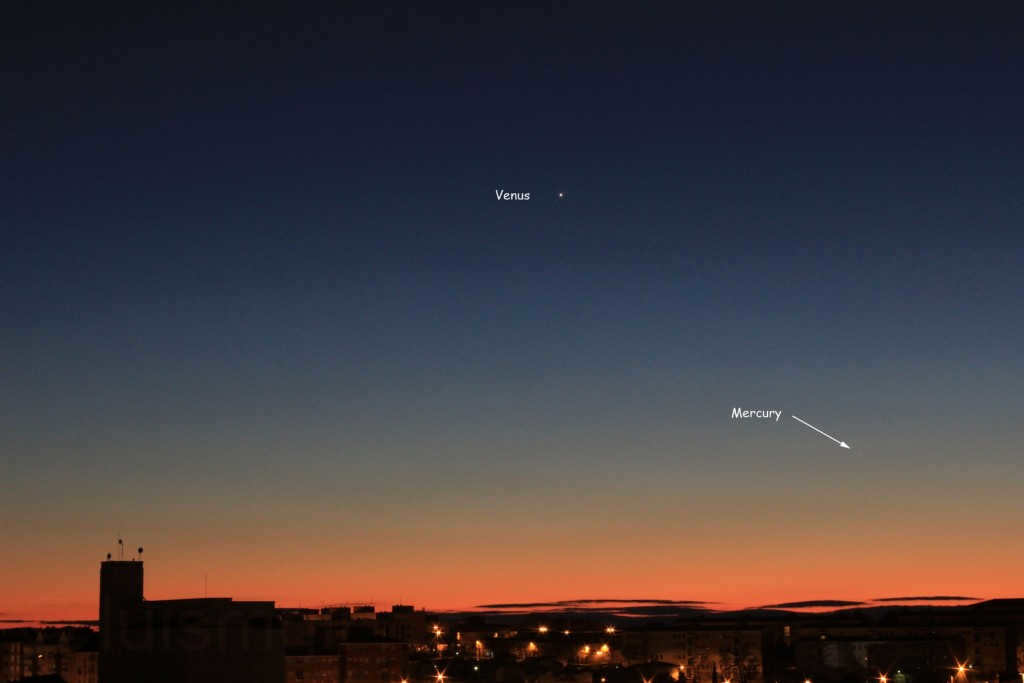
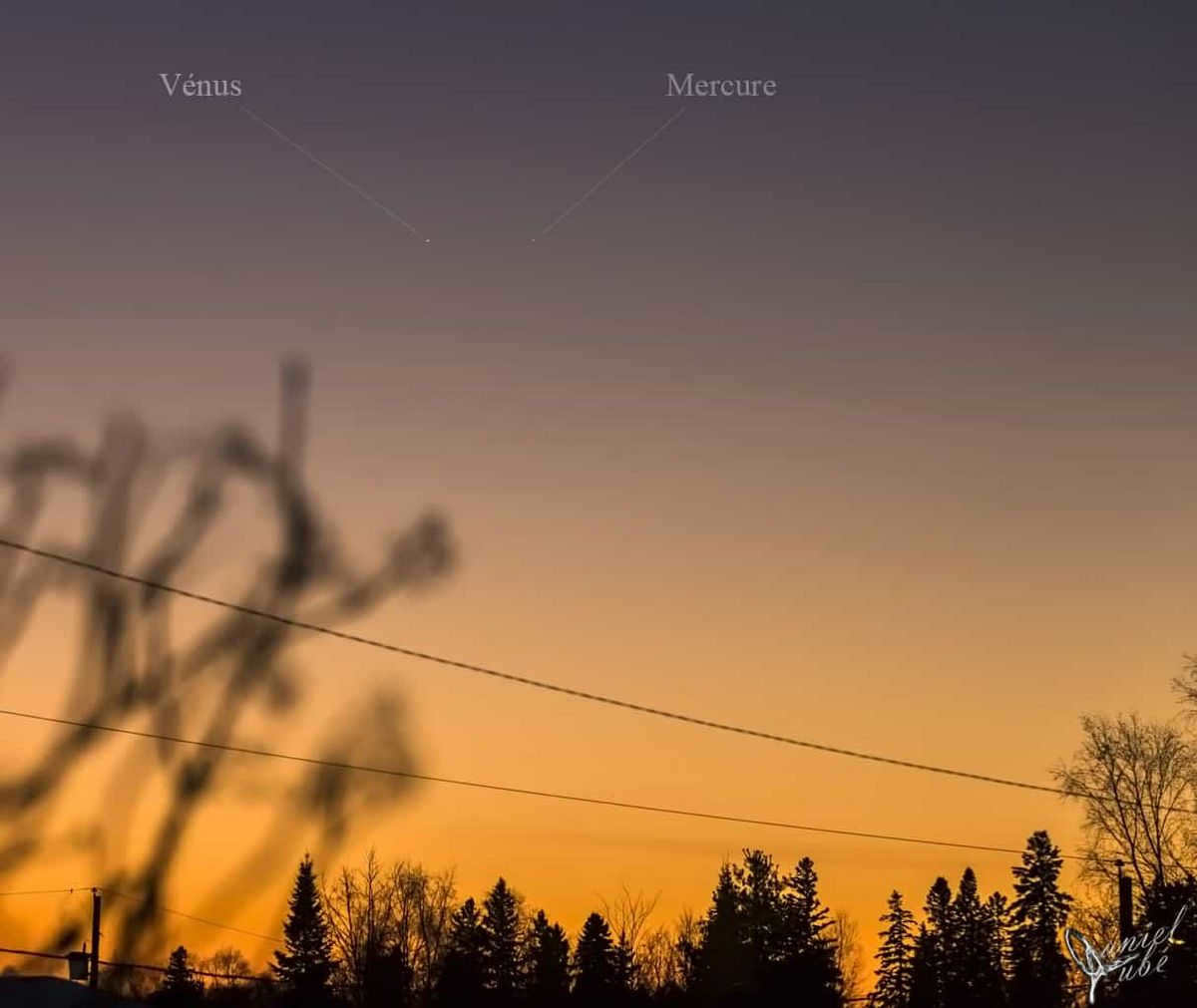
Images of Venus captured by amateur stargazers:
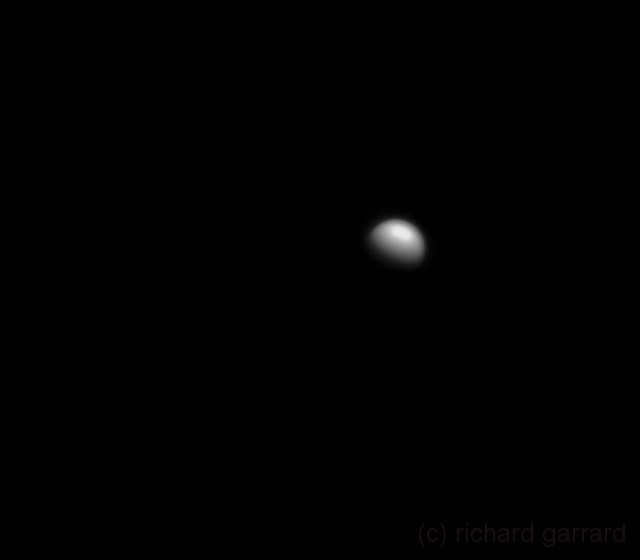
- Methods for observing the Sun
- Techniques for observing the Moon
- A hundred features on the lunar surface
- Observing Mercury and Venus
- Procedures for observing Mars
- Steps for observing Jupiter
- Guide to observing Saturn
- Observing Uranus, Neptune, and Pluto
- Solar Eclipse: How to observe
- Lunar Eclipse: Tips for observing
- Observing dark nebulae: A comprehensive guide
- Exploring globular clusters: Observational techniques
- Introduction to double stars: Key concepts
- The phenomenon of Polar Lights
- Silver clouds: Discovery, observations, and properties
Transforming a red star in the sky into a magnificent planet
August 20, 2020, 11:29, IA Amitel
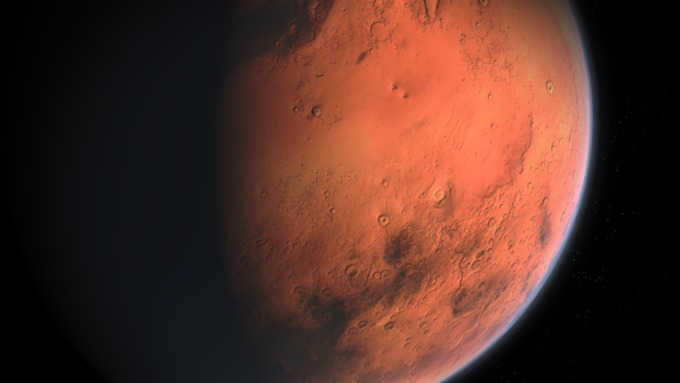
The “Viking-1” was sent to the distant and enigmatic Mars on August 20, 1975 from Earth. It became the first device capable of successfully landing on the surface of the red planet and conducting detailed studies. However, despite the anticipation, no signs of life were ever discovered. Presently, scientists and entrepreneurs are formulating plans to establish a colony on Mars. While tickets to Mars are not yet available, one can always gaze dreamily at it in the night sky. In fact, now is an ideal time to do so, as the planet will soon be at its closest proximity to us. We will inform you on how to locate the red planet, how to observe it, and what steps are required to catch a glimpse of its seas, clouds, polar caps, and much more.
What’s that crimson substance out yonder?
At present, rovers are being utilized to investigate the crimson planet. However, in the past, the sole instrument for examining Mars was a telescope. Nevertheless, even before its invention, a vivid red dot in the celestial sphere, which persistently shifted, fascinated the populace. It is documented that the stargazers of Ancient Egypt, dating back to a staggering one and a half millennia BC, were even capable of computing its path. Nonetheless, during that era, everyone firmly believed that Mars orbited the Earth.
Due to its crimson color, the celestial body has long been associated with conflict and warfare. Consequently, the ancient Greeks bestowed upon it the name of their deity of war – Ares. In Roman mythology, Mars served as its counterpart, revered as the patron saint of battles and skirmishes. Over time, this appellation became universally recognized for the planet. There exist alternative, albeit less plausible, yet more captivating theories about the origin of the red planet’s name. For instance, certain ancient scholars observed that Mars prominently appeared in the sky just prior to bloodshed, military conflicts, and uprisings, thus giving rise to its moniker.
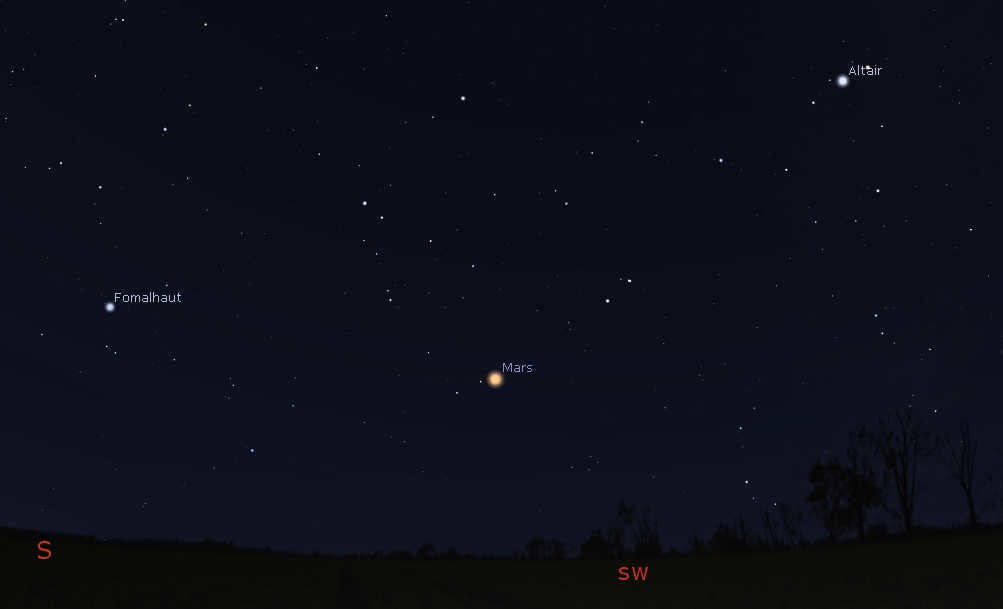
To observe Mars, one should search for a vivid and crimson celestial body in the atmosphere / Photo: Stellarium
Experiencing the sensation of a primitive astronomer is still possible in today’s world. Mars itself can be easily located in the expanse of the sky. Typically, individuals initially come across it amidst the stars, and subsequently resort to search engines to determine the identity of this radiant crimson celestial body. The planet is most prominently visible during its closest approach to Earth, which incidentally will transpire in the near future – October 13, 2020. Consequently, Mars is presently remarkably discernible in the sky.
When viewed up close, Mars reveals its true beauty
If you have ever gazed at Mars from a distance and felt slightly let down by its seemingly monotonous red hue, you are not alone. After all, Mars is located tens of millions of kilometers away from Earth. However, if you were to observe Mars through a powerful telescope, you would quickly discover that this planet is far from ordinary. It possesses a diverse landscape and is home to a range of fascinating weather phenomena.
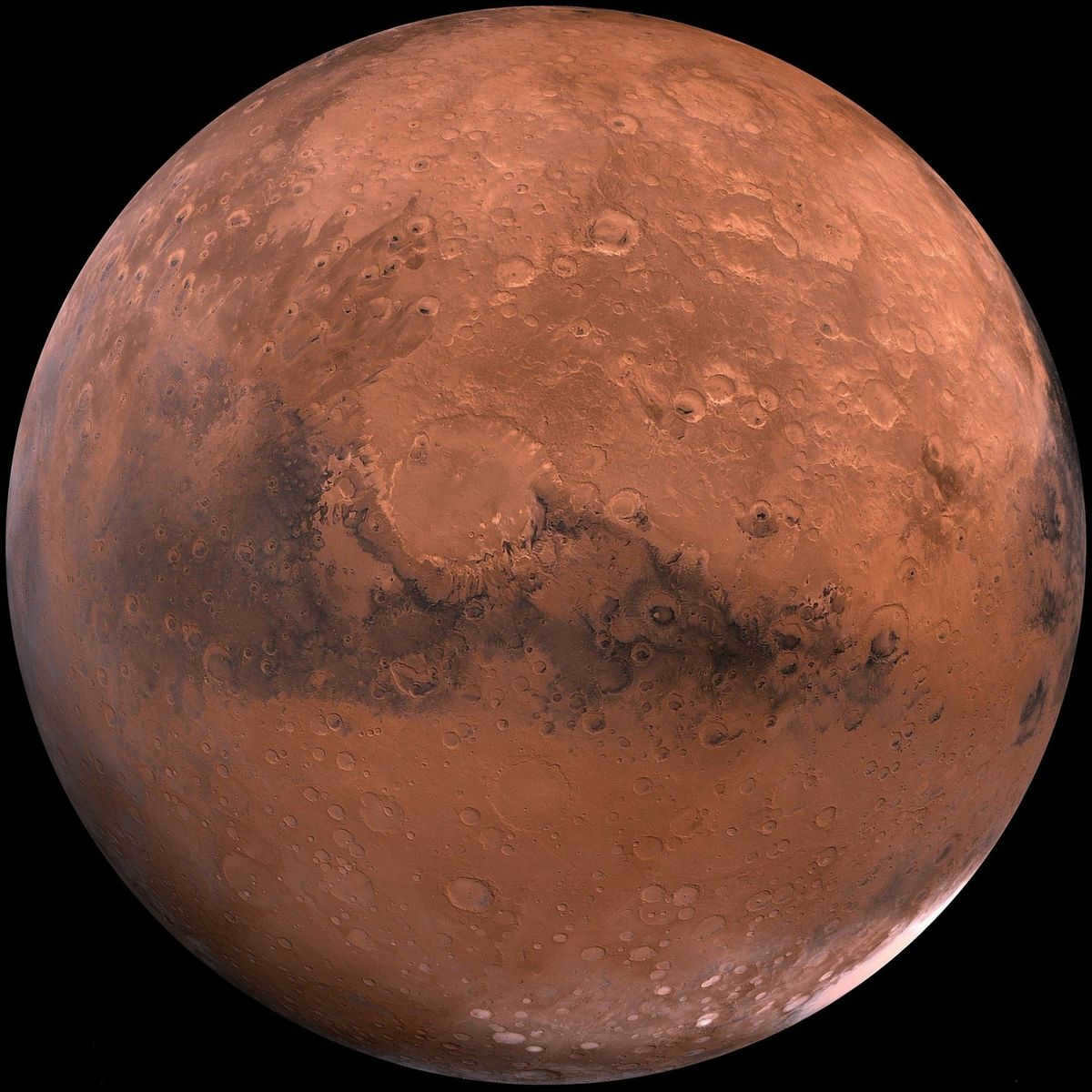
It is possible to observe the peculiar topography of Mars through a telescope / Photo: pixabay.com
With the introduction of advanced optics, astronomers were finally able to examine the topography of planets and make fascinating discoveries about their satellites. However, due to the limitations of the telescopes during that time and the absence of computer technology, there were instances of misinterpretation. One notable example occurred in 1877 when astronomer Giovanni Schiaparelli observed long channels on the surface of Mars. These channels appeared so orderly that Schiaparelli believed they were man-made trenches constructed by Martians in an effort to combat drought. Other astronomers also observed these channels, leading to the widespread popularity of the theory of intelligent life on Mars. However, this theory was debunked in 1965 when the first spacecraft approached the planet and revealed that there were no such channels. It was determined that what Schiaparelli had seen was merely an optical illusion.
What can be observed on Mars?
One of the most captivating sights to behold when observing Mars through a regular amateur telescope is its polar caps. These caps consist of frozen carbon dioxide (dry ice) and water, and can be found at the planet’s poles. An intriguing aspect to witness is how the seasons on Mars affect these polar caps. During spring and summer, a portion of the ice evaporates, causing a noticeable reduction in the size of the caps. However, come fall and winter, the planet’s poles experience a regrowth of ice, replenishing the caps once again.

"Deadly" boulders: The hazards of meteorites and how to protect yourself
In addition, there are bodies of water on Mars. So if you are unable to visit the beach this summer, you can at least catch a glimpse of the Martian seas through a telescope (otherwise, you’ll miss out). However, these features are only referred to as seas in a figurative sense, as they do not contain water. Oh, if only you had lived a few centuries earlier, you could have been the one to name these bodies of water. Unfortunately, that honor goes to Giovanni Schiaparelli, who was the first to discover them. Thus, the map of the red planet now includes the Sea of Aphrodite, Eritrean, Adriatic, Cimmerian, Lunar, Phoenix, and Lake of the Sun.
Speaking of the oceans, if you observe them for an extended period, you can witness their ever-changing shape. However, this is not some sort of magic but rather a result of other phenomena on Mars: clouds and fogs. These formations are believed to emerge from the melting of the polar caps and partially cover the planet’s surface.
The Moons of Mars
With the help of a telescope, one can also spot the satellites of Mars. However, it requires a certain level of skill and astronomical experience. Phobos and Deimos are significantly smaller than Mars, which often causes them to get overshadowed by the planet’s brilliance. Nevertheless, there is a foolproof method to observe the entire Martian family. By removing Mars itself from the field of view and locating its faint companion, one can then bring Mars back into focus. This approach increases the chances of closely observing both celestial bodies.
Where can I buy a high-quality telescope?
You can find a wide range of telescopes at specialized optical stores. It’s recommended to explain to the store consultant your specific needs and requirements, so they can help you choose the best telescope for you. For instance, amateur 60-millimeter telescopes are capable of observing Mars, but to see more interesting details, a 150-millimeter reflector (mirror telescope) or a 100-millimeter refractor (lens telescope) would be more suitable.
However, it’s important to consider that an excessively large lens diameter can have a negative impact on your observations. This is due to the Earth’s atmosphere, which constantly moves and causes image distortion. Therefore, in a 350-millimeter telescope, the image may appear unstable and blurry.
If the telescope is equipped with a clock mechanism, it would greatly enhance its usefulness. This way, one wouldn’t have to constantly readjust the optics to keep up with the ever-moving Mars.
To obtain a clearer view of all the fascinating features on Mars, it is advisable to employ colored light filters for the telescope. For instance, using a red filter can amplify the contrast, making the Martian seas more distinct. Yellow and orange filters can bring out the red areas and finer details of the planet. Additionally, blue and violet filters are ideal for observing clouds and fog on Mars.
Don’t confine yourself to Mars: there are still numerous celestial bodies in the vastness of space that can be observed with fascination using a telescope. But be forewarned: once you peer at far-off planets through an optical instrument, you may find yourself forever captivated by the wonders of astronomy. Even though the era of groundbreaking telescope revelations has long passed, amateur astronomers continue to devote their nights to gazing into the infinite expanse of the cosmos.
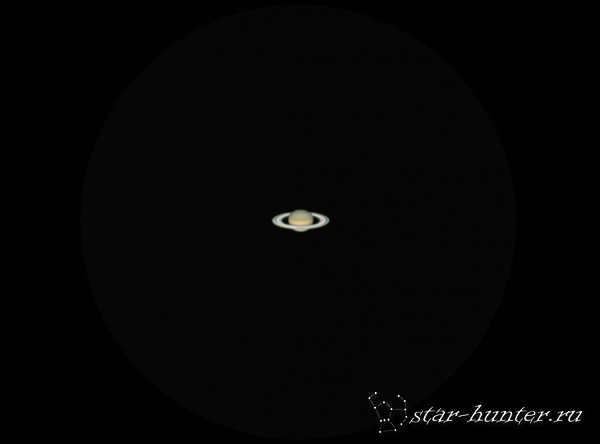
Saturn is truly a stunning planet that never fails to captivate me, even after countless viewings. Its sheer beauty leaves me in awe every time. While the presence of its iconic rings can be observed with a modest 50-60 mm telescope, the best way to truly appreciate this planet is through the lenses of a larger telescope, preferably with a diameter of 150-200 mm. With such a telescope, one can easily marvel at the black gap between the rings known as the Cassini slit, as well as observe the intricate cloud belts and numerous satellites that orbit this magnificent planet.
A crude observation of Uranus made with a 200 mm telescope
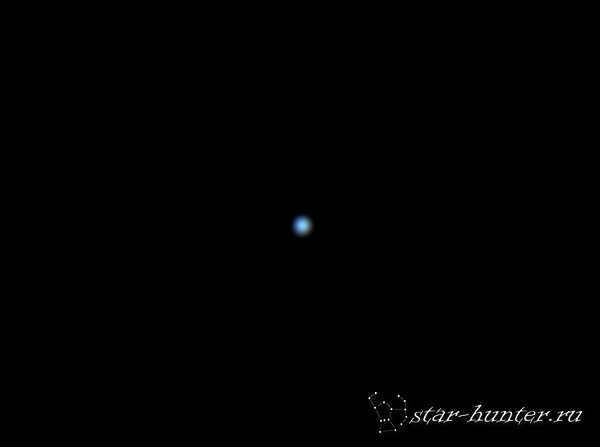
Uranus and Neptune, unlike the other planets, orbit in distant regions of our solar system. When observed through smaller telescopes, they may appear as mere stars. However, with the aid of larger telescopes, one can discern their diminutive bluish-greenish disks, although no intricate features will be visible.
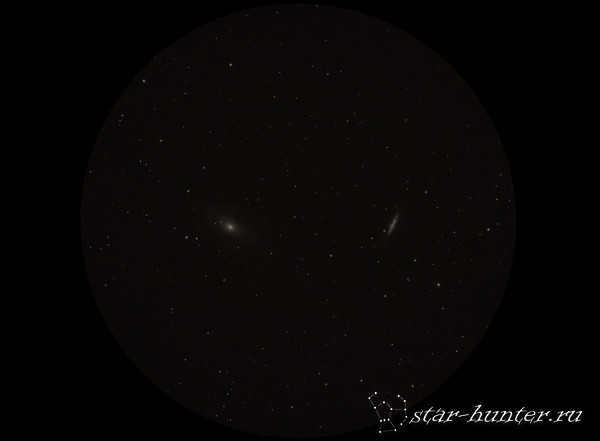
Galaxies are not only visible through a telescope, but also through binoculars. You can locate them, not just observe them. When viewed through a telescope, they appear as small, colorless dots. However, with a diameter of 90-100 mm or larger, bright galaxies can be seen to have a distinct shape. The Andromeda Nebula is an exception, as its shape can be easily seen even with binoculars. It is worth noting that spiral arms are not visible until a diameter of 200-250 mm, and even then, they are only visible in a few galaxies.
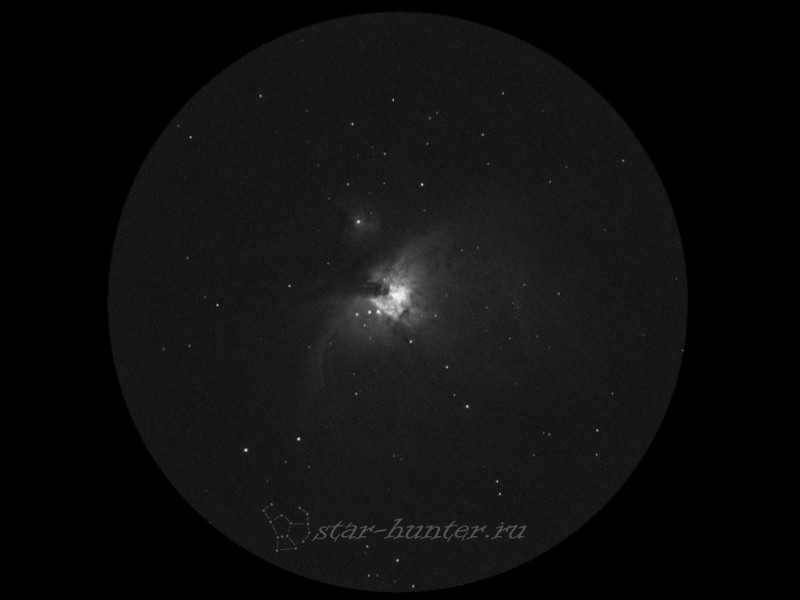
Astrophysical phenomena known as nebulae are formations of interstellar gas and/or dust that are illuminated by either other stars or remnants of stars. While they may appear as faint spots when observed through a small telescope, larger telescopes (ranging from 100-150 mm) provide the ability to discern the shape and structure of most prominent nebulae. Among the most brilliant nebulae is M42, located in the Orion constellation, which can even be seen without the aid of a telescope. When observed through a telescope, M42 reveals a complex gaseous structure that resembles billows of smoke. Additionally, certain compact and luminous nebulae exhibit distinct colors, such as the Turtle Nebula NGC 6210, which appears as a small, bluish disc.
Observing the Sun with a telescope equipped with a solar filter allows us to see its spots
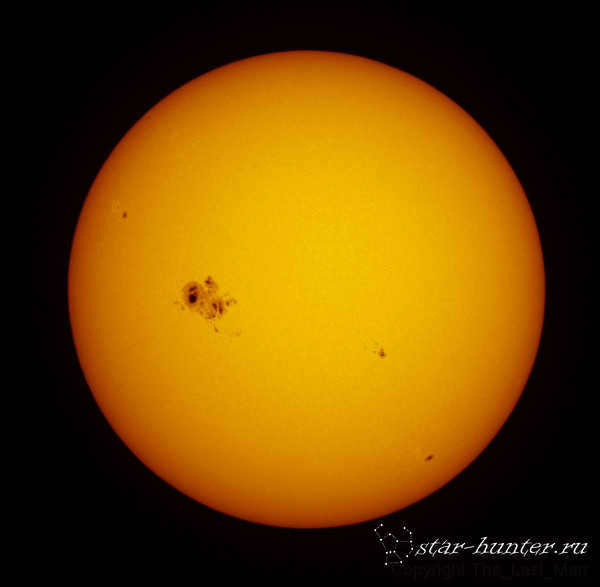

Let me emphasize the importance of caution when it comes to observing the Sun. Without proper protective equipment, it can be extremely dangerous. It is crucial to use a specially designed solar filter that securely attaches to the front of the telescope. Alternative options such as tinting films, smoked glass, or floppy disks should never be used. Your eye safety should always be a top priority. By following all necessary precautions, even with a small telescope measuring 50-60 mm, you will have the opportunity to observe sunspots – dark formations on the surface of the Sun. These spots are where magnetic lines emerge. Due to the Sun’s rotation period of approximately 25 days, daily observations of sunspots will allow you to witness the Sun’s rotation.
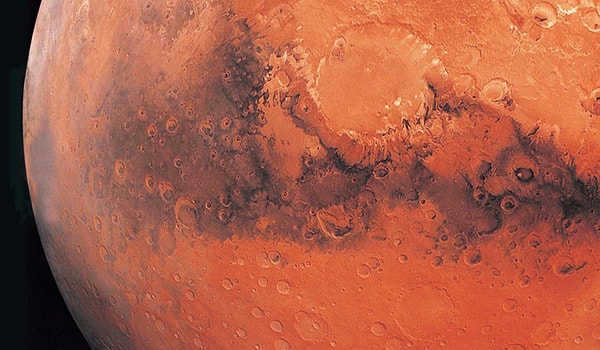
What Earth sees when looking at Mars
Mars, the red planet, has been capturing the attention of scientists and space enthusiasts alike. Numerous countries and international research organizations have been sending orbiting satellites and planetary vehicles to explore and understand the appearance of Mars.
Observing Mars is not limited to these expeditions and scientific missions, as it can also be observed from Earth with the aid of telescopes, revealing its distinctive red glow in the night sky.
Telescope observations of Mars in the night and morning sky
One can observe Mars in the night and morning sky by simply using a telescope. On regular days, it can be quite challenging to spot the planet. The optimal time to do so is during Mars’ oppositions, when Mars appears larger in size. The most favorable viewing time is between 12am and 4am.
Unfavorable atmospheric conditions, excessive cloud cover, strong gusts of wind causing the telescope to oscillate, and even dust storms occurring on Mars itself can temporarily hinder the visibility of the planet.
The best visibility of Mars occurs when the planet is in perihelion, which coincides with its opposition. It is nearly impossible to see Mars when it is near aphelion.
Oppositions of Mars are typically observed every two years and fifty days.
The most fascinating, known as “great” oppositions, occur once every 15 to 17 years. During these times, Mars can be observed from Earth throughout the entire night, allowing for a view of its movement and distinct red hue that sets it apart from other planets.
To view Mars through a telescope, proper adjustments must be made and the use of the correct refractor or reflector is essential. Enhancing the visibility of the planet can be achieved by selecting the appropriate color filter.
Even with a sixty-millimeter telescope, a somewhat discernible image of Mars can be obtained, appearing as a small orange dot resembling the size of a pea.
Under favorable conditions of Mars’ largest visible diameter, one can observe both light and dark markings on the planet. The polar ice caps of Mars are also visible through a telescope.
Using a telescope, it is also possible to easily witness the transformation of the polar cap in the northern hemisphere of Mars. The melting of ice leads to the formation of water, which can be seen as dark bands in the circumpolar zone when observed through a telescope.
Interestingly, ground-based telescopic studies of Mars’ northern ice caps have revealed that the volume of ice in these caps is equivalent to the ice sheet of Greenland. Scientists propose that this ice may have once existed in a liquid state, forming a vast ocean. Nowadays, this area is occupied by the Northern Plain in the low-lying region of the hemisphere.
The possibility of observing Mars lasts for a period of six months. The most optimal time for observations is considered to be the forty days prior to and following the opposition.
Mars in the nighttime celestial sphere
During regular nights, Mars appears as a faint celestial body in the sky. However, during the grand opposition, it becomes visible to the naked eye: a small, bright circle with a reddish hue. During this time, Mars shines twice as brightly as Jupiter.
To locate Mars in the nighttime sky, one can use a compass. By finding the east and south directions and looking in between, closer to the south, the brightest celestial body in that area will be Mars.
Viewing Mars with binoculars can be challenging because space objects need to be observed through a stationary device. When holding binoculars, it is impossible to focus the image properly as any slight movement will cause it to move out of the field of view.
What Mars looks like from space
From space, Mars appears as a bright reddish sphere. The visibility of physical features like mountains, volcanoes, and valleys depends on the weather conditions. During dust storms, these features may appear blurry.
Mars as seen from a satellite
Spectacular satellite imagery of Mars offers a unique perspective, allowing us to observe not only the planet’s surface but also the dynamic weather patterns. The satellites have captured clear weather conditions in the northern region, while a dust storm has begun to form in the southern part of the planet. As the dust storm intensifies, a reddish haze blankets the Martian surface, obscuring everything in its path.
These remarkable instruments also reveal the changing seasons on Mars. In the northern hemisphere, autumn is signaled by the presence of cloud cover, creating a hazy atmosphere. On the southern side, the onset of spring is evident as the ice caps darken, eventually melting away completely during this season.
Additionally, photographs of Mars rovers were taken from a distance of approximately two thousand kilometers, capturing the planet’s most renowned landmarks. For instance, the image of the valley known as Mariner depicts the complete surface structure of the largest canyon, measuring two thousand kilometers in length and approximately eight kilometers in width. The Mariner Valley stretches alongside the Labyrinth of Night, slightly shifting towards the east. The central area of the canyon’s northern section reveals the remnants of ancient rivers that once flowed in a northerly direction.
The volcanoes situated in the western region of Tharsis are clearly discernible in satellite imagery. These Martian volcanoes appear as dark-red spots, with a width of up to 25 kilometers.
How Mars Appears from the Moon
When observing outer space, one can also catch a glimpse of Mars from the Moon. These two celestial bodies are in close proximity to each other, with a distance of about 55.42 million kilometers between Mars and the Moon. Interestingly, this distance is similar to the Earth’s distance from Mars (55.76 million kilometers).
Unlike observing Mars from Earth, the view of the planet from the Moon would be much clearer. This is because the Moon lacks an atmosphere, which can hinder the visibility of Mars.
Within the vastness of space, Mars and the Moon are surrounded by an array of stars and nebulae. Among these, the Laguna and Triple Dividing Nebulae shine the brightest. Such a spectacle is truly awe-inspiring.
One can only imagine how Mars may have looked in the past, what it looks like now, and how it appears from within.
There have been numerous theories regarding the appearance of Mars approximately 4-5 billion years ago. According to scientists, the planet was predominantly covered in water. If we were to envision Mars during that time period, it would bear a resemblance to Earth due to the presence of water and land on its surface. Mars boasted an expansive and deep ocean with depths exceeding 5,200 feet, spanning nearly 19% of the planet’s total surface area. In comparison, the Atlantic Ocean covers approximately 17% of Earth’s surface.
At present, Mars contains water in the form of ice caps located in its northern hemisphere. As Mars’ atmosphere is primarily composed of carbon dioxide, it freezes during the winter, resulting in the formation of ice. Additionally, the bottoms of the planet’s craters and trenches are enveloped in dense fog.
Discovering the True Appearance of Mars
When we take a closer look at Mars, we can see that its surface is composed of a diverse array of rocky particles, including silica and clayey rocks. Similar to Earth, Mars is adorned with towering mountains, deep depressions, expansive plains, and vast lowlands. The planet is also home to sand valleys and a multitude of cooled volcanoes. These fascinating features are the result of impact craters left behind by larger celestial bodies colliding with Mars.
What truly captivates the eye is the vibrant color of Mars’ surface, which exudes a reddish hue. This unique spectacle is caused by the presence of iron oxide in the soil. We are fortunate to be able to witness this stunning sight through the images captured by various planetary rovers that have been sent to explore Mars on multiple occasions. One particularly intriguing phenomenon on Mars are the ribbed dunes that ensnare the Martian soil, leading to irreversible shifts in the planet’s surface.
Discovering the Inner Secrets of Mars
While it may be impossible to physically observe the interior of Mars, scientists have employed a range of scientific calculations to reconstruct the planet’s internal structure. Through paleontological calculations of density and gravity parameters, researchers have been able to develop a rough understanding of what lies beneath the surface.
Data collected from various spacecraft missions has provided valuable insights into the heterogeneity of Mars’ crust. It has been observed that the northern hemisphere has a significantly thinner crust compared to the southern hemisphere. This has led to the hypothesis that Mars once had an extremely thin crust, which was possibly reinforced by collisions with large asteroids.
Currently, it is believed that the crust of Mars ranges from 70 to 100 kilometers in thickness.
Through radiosounding of the southern hemisphere, a fascinating discovery has been made – deep beneath the surface of Mars, there exist brackish-water lakes where various life forms may have originated or are currently thriving.
Exploring Mars opens up new frontiers of knowledge and provides us with the opportunity to marvel at the planet’s celestial beauty when observed through a telescope. Additionally, spacecraft images offer a closer look at Mars, helping to answer longstanding questions that have piqued our curiosity for years.
Did you find the information helpful? Share it on social media!
Many internet users have often wondered why there is a lack of nighttime photos from the surface of Mars. However, it turns out that there are indeed night photos, but NASA doesn’t frequently release them to the public. This could be because they are considered less appealing or perhaps because only a few people have seen them. Nonetheless, these photos can be found on NASA’s official website.
One of the photos showcases the Martian moon Phobos in the night sky. It’s interesting to note that the stars aren’t particularly visible in the image. It’s possible that during the time this photo was taken, the stars hadn’t yet become apparent in that specific part of the sky.
This is our perspective from a closer vantage point, and it certainly presents an intriguing form. Experts in astrophysics suggest that its size is too small to maintain a spherical shape. According to calculations made by NASA scientists, due to the gravitational pull of Mars, Phobos could potentially collide with the Martian surface in approximately 9-10 million years. Currently, Phobos is gradually descending towards the surface at a rate of about 2 meters per century.
As we are aware, Mars has not one, but two natural satellites – Phobos and Deimos. Although I have not personally observed images of Deimos from the surface of Mars, it is expected to appear even smaller in the sky. Its diameter measures 10.4 kilometers.
An image showcasing the drilled surface of the Martian soil, captured during the nighttime.
This particular photograph was taken on June 6, 2013, during the nighttime using a built-in camera equipped with illuminating white ultraviolet LEDs, onboard the U.S. Mars rover Curiosity.
Mars is a planet that has captured the curiosity of scientists and space enthusiasts worldwide due to its mysterious nature. When observing Mars through a telescope, one can obtain a comprehensive visual representation of the enigmatic planet.

Observing the Appearance of Mars
Mars, a celestial body that continues to captivate the attention of scientists and space enthusiasts alike, is attracting a growing number of observers. Numerous countries and international research organizations have embarked on missions to send orbiting satellites and planetary vehicles to explore and study Mars, aiming to uncover its true appearance.
One can catch a glimpse of the planet not only through the lens of these specialized vehicles, but also by observing Mars’ distinctive red glow in the night sky using a telescope.
Observations of Mars in the night and morning sky using a telescope
To catch a glimpse of Mars in the night and morning sky, all you need is a trusty telescope. On regular days, spotting the planet can be quite challenging. The optimal time to do so is during Mars’ oppositions, when its apparent size is at its largest. The best viewing window for the planet is after midnight and before 4 am.
However, unfavorable atmospheric conditions, excessive cloud cover, strong gusts of wind that cause the telescope to shake and result in a shift in focus, as well as dust storms on Mars itself, can temporarily disrupt the visibility of the planet.
The clearest view of Mars is typically obtained when the planet reaches perihelion, which coincides with its opposition. When Mars is close to aphelion, it becomes nearly impossible to observe.
To observe through a telescope, you must make the necessary adjustments and, of course, choose the appropriate refractor and reflector. The visibility of the planet can be enhanced by selecting the correct color filter.
Even a telescope with a sixty-millimeter aperture can provide a minimally visible image of Mars; Mars will appear as the size of a small orange.
Under optimal conditions, it is possible to observe light and dark spots on Mars, as well as the Martian polar ice caps, through a telescope.
Using a telescope, it is also possible to easily monitor changes in the polar cap in the northern hemisphere of Mars. As the ice melts, water forms and is visualized in the telescope as dark bands in the circumpolar region.
Curiously, through the examination of the northern ice caps of Mars using telescopes located on Earth, it has been determined that the quantity of ice in these caps is equivalent to the ice sheet found in Greenland. Researchers propose that in the past, this ice may have existed in a liquid state and formed a vast ocean. Presently, this area is occupied by the Northern Plain in the lower region of the hemisphere.
The observation of Mars is feasible for a period of six months. The most favorable time periods for conducting observations are considered to be the forty days prior to and following the opposition.
Mars in the night sky
Under normal circumstances, Mars is barely visible in the night sky. However, during the great opposition, it becomes much more prominent and can be easily spotted even without the aid of a telescope. It appears as a small, bright circle with a distinctive reddish hue. In fact, during this time, Mars shines twice as brightly as Jupiter.
To locate Mars in the night sky, you can use a compass as a guide. By finding the eastern and southern directions and looking in between, closer to the south, you will be able to identify the brightest planet in that area, which is Mars.
Observing Mars with Binoculars
Looking at Mars through binoculars can be a challenging task because observing objects in space requires the use of a stable mounting system. Since binoculars are held in your hands, it is difficult to achieve a clear focus on the image. Even slight movements can cause the image to shift out of the field of view.
About the appearance of Mars from space
When viewed from space, Mars appears as a vibrant red sphere. The visibility of physical features such as mountains, volcanoes, and valleys will vary depending on the weather conditions. During periods of dust storms, these features may appear blurred.
Mars as seen from a satellite
The satellite images of Mars are truly breathtaking: they allow us to observe not only the planet’s surface, but also the ever-changing weather patterns. These images have captured clear weather on the northern side of the planet, as well as the onset of a dust storm in the southern region. As the dust storm begins, reddish particles accumulate over the surface of Mars, eventually obscuring everything in its path.
Moreover, images of Mars rovers were captured from a distance of approximately two thousand kilometers, showcasing the planet’s most renowned landmarks. For instance, the photograph of Mariner Valley reveals the intricate surface formations of the largest canyon, spanning two thousand kilometers in length and around eight kilometers in width. Mariner Valley runs parallel to the enigmatic Labyrinth of Night, veering slightly towards the east. The central portion of the canyon in the northern region showcases the remnants of ancient rivers that once flowed in a northerly direction.
The satellite images clearly display the volcanoes situated in the western region of Tharsis. These Martian volcanoes appear as discernible darkish-red spots in the photographs, with widths of up to 25 kilometers.
How Mars appears when viewed from the Moon
When observing the night sky from outer space, it is possible to catch a glimpse of Mars from the Moon. These celestial bodies are in close proximity to each other, with a distance of approximately 55 million 420 thousand kilometers separating them. Interestingly, this is roughly the same distance between Mars and Earth, which is 55.76 million kilometers.
Unlike the view of Mars from Earth, the Moon provides a clearer and more distinct perspective of the planet. This can be attributed to the absence of the Moon’s atmosphere, which often hinders the observation of celestial objects.
Furthermore, both Mars and the Moon are surrounded by a vast expanse of stars and nebulae. Among the most prominent of these cosmic formations are the Laguna and Triple Dividing Nebulae. Witnessing such a spectacle is truly awe-inspiring.
Contemplating the appearance of Mars throughout history, its current state, and even pondering what it may look like from within, fills us with a sense of wonder and curiosity.
Imagining Mars with Water
There have been numerous speculations regarding the appearance of Mars billions of years ago, with scientists suggesting that it was once predominantly covered in water. If we were to envision Mars in its ancient state, it would bear a striking resemblance to Earth, featuring both water and land on its surface. Mars boasted an expansive and profound ocean that could have reached depths exceeding 5,200 feet, covering nearly 19% of the planet’s total surface area. To put this in perspective, Earth’s Atlantic Ocean encompasses approximately 17% of the planet’s surface.
Currently, Mars harbors water in the form of ice caps located in its northern hemisphere. The planet’s atmosphere, composed primarily of carbon dioxide, causes water to freeze during the winter season, resulting in thick fog that blankets the bottoms of Mars’ craters and trenches.
Unveiling the True Appearance of Mars
The surface of Mars is adorned with a mosaic of rocky particles of different sizes (silica) and clayey rocks, rendering it a truly remarkable planet. Similar to Earth, Mars boasts an assortment of mountains, depressions, plains, and lowlands. This captivating world also features sandy valleys and an array of cooled volcanoes. The craters on Mars are the result of powerful impacts from celestial bodies of significant size.
Upon closer inspection, Mars reveals its stunning topography and its surface, which is characterized by a mesmerizing reddish tint. This distinctive coloration is attributed to the presence of iron oxide in the soil. We are able to witness this extraordinary spectacle thanks to the images captured by planetary rovers that have been dispatched for exploration missions on multiple occasions. One intriguing phenomenon on Mars is the formation of ribbed dunes that ensnare the Martian soil, resulting in permanent shifts in the planet’s surface.
Exploring the Internal Structure of Mars
Although we cannot physically observe the inside of Mars, scientists have devised various scientific calculations to reconstruct its internal composition. By studying parameters like density and gravity, paleontologists have been able to develop a general understanding of the planet’s inner workings.
Data collected from spacecraft missions have provided valuable insights into the non-uniform thickness of Mars’ crust. It has been observed that the crust in the northern hemisphere is significantly thinner compared to the southern hemisphere. This discrepancy has led to a hypothesis suggesting that Mars once had an extremely thin crust, which was subsequently thickened by collisions with large asteroids, ultimately halting the planet’s core.
Currently, it is believed that the crust of Mars measures approximately 70-100 kilometers in thickness.
Through radiosounding of the southern hemisphere, a discovery has been made that there exist brackish-water lakes beneath the deep layers of soil inside Mars, where certain life forms can potentially originate or have already originated.
Studying Mars enables us to push the boundaries of the unknown, to marvel at the planet’s beauty in the night sky when observed through a telescope, with our own eyes. Additionally, the images captured by spacecrafts enable us to gain a closer understanding of the planet and find answers to long-standing questions.

The image depicts a sunset in the Ares Valley (Ares Vallis) during the month of July in 1997 at 16:10 local solar time. The colors captured in the photograph closely resemble the true colors of the scene.


The initial moment after the sun disappears below the horizon on Mars.
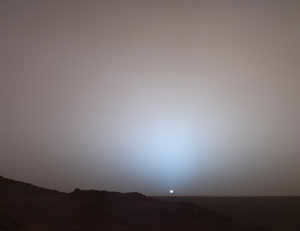
On the evening of April 23, 2005 (464 sol), a captivating picture was captured, showcasing the twilight at Gusev crater. The image remarkably captures the colors that would be perceived by a human observer. The bluish hue of the sky in the vicinity of the setting Sun is accurately depicted, while the redness of the sky in the distance from the sunset is slightly amplified.
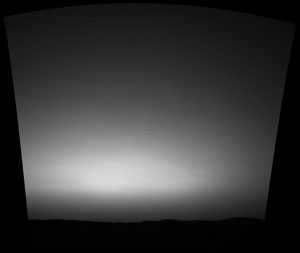
Our Earth is the small star that shines brightly in the midst of the dark Martian night sky.
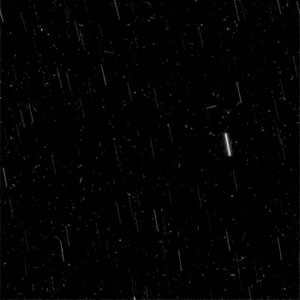
There is a high level of focus on the study of Mars this year. The Perseverance rover provides us with new information about the Red Planet on a daily basis. Recently, the rover’s camera captured a stunning image of the starry sky on Mars. This camera is part of the rover’s advanced meteorological system called MEDA, which stands for Mars Environmental Dynamics Analyzer. MEDA plays a crucial role in studying the climate conditions on Mars by collecting and analyzing data every day.
The atmosphere of Mars
The MEDA system is comprised of the SkyCam, a revamped iteration of the Hazcam camera. Aptly named, the camera is designed to capture images of the sky.
SkyCam/ NASA
The primary objectives of the camera are twofold:
- To capture photographs of clouds moving across the sky of the Red Planet.
- To measure the optical thickness of aerosols in the atmosphere.
The photographs were taken between 01:10 and 01:13 Mars time. The image, speckled with stardust, reveals traces of heavy charged particles and a luminous spot. Scientists hypothesize that the blemish is Phobos, one of Mars’ two moons.
SkyCam/NASA image
Mega-functional MEDA
MEDA is a cutting-edge control unit and environmental sensor system designed to collect and analyze data on dust properties and other atmospheric parameters. These critical metrics are essential for monitoring and understanding the meteorological conditions on Mars.
The MEDA system and its advanced sensors are strategically positioned on the rover’s mast, deck, and interior, allowing for comprehensive data collection and analysis.

